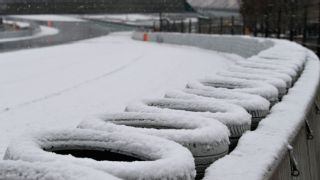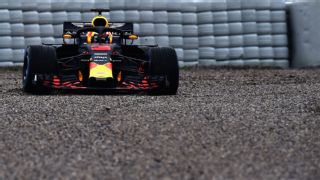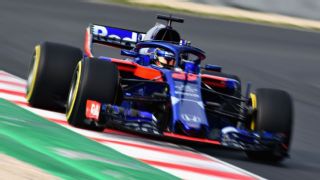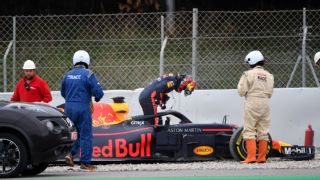|
The first pre-season test of 2018 was a memorable week. When the paddock was greeted by freezing temperatures on Tuesday morning and a thin layer of snow on Wednesday, it was clear that the best laid plans of all ten teams would go awry. As is the nature of Formula One, the paddock made the best of a bad situation but the majority of the big questions ahead of the new season remain unanswered. Why did the cold weather have such an impact? The seasonal average temperature at the Circuit de Catalunya in late February is 15 degrees Celsius, but for the first three days of testing the mercury struggled to rise above zero when the pit lane opened. Track temperatures remained stubbornly in single figures for the majority of the first three days and that's a major issue for a Formula One car, which have been engineered specifically to operate in hot conditions as the F1 calendar chases summer around the globe. The biggest problem is the tyres. Pirelli's compounds -- even the ones that have been developed to work in relatively cool conditions during the season -- need to reach at least 90C in order to turn the tyre on. The only way to reach that threshold for the first three days of testing this week was to push the tyres as hard as possible over longer runs. But even when the necessary temperatures were generated through some of Barcelona's high-speed corners, the tyres immediately started haemorrhaging temperature and performance along the pit straight. Teams have several tricks up their sleeves to use heat from the brakes to generate bulk tyre temperature, but with the brakes also running cold it created a chicken-and-egg situation: Drivers needed to push hard to generate tyre temperature but they also needed tyre temperature to push hard. "The conditions are very difficult so we have to try to get the car and tyres in the correct operating window," Williams reserve driver Robert Kubica explained after testing on Tuesday. "My worry was only to go as fast as possible on the out lap [from the pits] in order not to cool down the tyres because once they are cooled down we have no margin and we have to come in as we can't stay on the track. "If people were around and saw my first lap on used tyres, I looked like a clown and looked like I've never driven any racing car, and certainly not an F1 car, in my entire life! Even if you are the best in the world and have all the data, sometimes you don't realise how difficult it is for a driver to drive the car even in a safe way." What's more, the long runs needed to build tyre temperature are not necessarily conducive with the systems checks and minor tweaks a new F1 car requires in its first few hundred kilometres on track. As a result, the extreme conditions called for extreme measures. "You need to allow heat from the brakes into the rims to have a chance of getting heat into the tyres in these conditions and we didn't do that," Kevin Magnussen explained after running wide and into the gravel at Turn 4 on Tuesday. "So we were expecting to survive without cutting in the brake drums, but eventually we realised there was no chance -- we needed to modify it to get some heat, and then it was fine. But that run was worse than being in the wet on slicks -- it was worse than that. I was on an out lap and I couldn't stay on track."  With the exception of Thursday afternoon, when temperatures finally crept above 15C and the sun briefly warmed the track surface to 25C, there was no chance of conducting anything close to meaningful performance testing. But that doesn't mean the laps over the first three days were a complete waste of time. "There's a lot we haven't been able to do, obviously," Toro Rosso technical director James Key said. "One of the first things you want to do is tyres, which is very difficult in these conditions so we've had to adapt the programme a bit. I think we have been able to do some useful, very basic setup work so we've made a good step for example on the second day when we began to get into the car and we were able to optimise the way the platform was and so on, quite a bit. "I think we've been able to do some setup work, with the length of time it's taken to get the tyres in we've done a bit of durability in a sense as well because some of the runs have been quite long. "We can't really make an assessment on things like cooling systems in these conditions so still a lot work to do, but some of the basics have been covered and we've done some initial things, a bit of pit stop practice, some starts and that sort of thing, so operational things that you can fill in with which you plan anyway but are a lower priority. We've tried to make, as everyone has, the best use of time really." Who did it best? It seemed ominous for Mercedes' rivals that as the sun came out and track temperatures peaked on Thursday afternoon, it was Lewis Hamilton who sat half a second clear at the top of the timesheets. He set a 1:19.333 on the medium compound tyres while Stoffel Vandoorne in the McLaren was 0.5s shy on the hyper-softs (a compound four steps softer than Hamilton's mediums) and Sebastian Vettel was 0.9s off using the softs. On paper that may look like a big gap, but Pirelli believes the teams haven't even begun to scratch the surface in terms of performance. Using the softer tyres in the range, lap times are expected to drop by over a second in the second week to times as low as the high 1:17s. It would be wise, therefore, to wait until teams have conducted some obvious qualifying simulations before drawing any conclusions. It's also worth noting that the medium tyre was surprisingly quick in the cold conditions, ostensibly because its stiffer construction helped combat the graining suffered on the front-left tyre when using some of the softer compounds. Viewed in that light, Hamilton's quick lap on a harder compound than his rivals is not quite as impressive as it first seems, especially with fuel levels remaining as testing's great unknown and one of the major players in single-lap performance. But while the lap times from the first week of testing are largely irrelevant, the mileage completed by each team is not. All ten teams had their running limited by the weather, yet some were still able to make better use of the conditions than others.  The award for the most laps goes to Toro Rosso and, surprisingly given its struggle for reliability in recent years, the team's engine supplier Honda. The new partnership completed 324 laps across all four days, which was 18 more than Mercedes managed in the same period and 26 more than Ferrari. Arguably Mercedes and Ferrari could have done more laps had they not sat out of the majority of the wet running, but the important part is that the Honda ran without major issues across all four days. What's more, if the new Honda engine was turned down for reliability's sake, it didn't show in the speed trap, with Pierre Gasly achieving the same speed (333.3km/h) on Thursday as Hamilton in the Mercedes. Only Sebastian Vettel in the Ferrari (334.3km/h) and Kevin Magnussen in the Haas (336.4km/h) were faster. McLaren recovered from two reliability issues in the first two days to complete a solid day of 161 laps on Thursday. The first issue was caused by a wheelnut being undertorqued ahead of Fernando Alonso's first proper run, which left the Spaniard beached in the gravel with three wheels on his wagon. The second issue occurred on Tuesday when a £2 clip worked loose from the exhaust, melting the wiring loom at the rear of the car as it was exposed to intense heat from the exhaust gasses. Alonso braved the worst of the week's conditions by clocking up 11 laps and the only lap times on Wednesday before sharing Thursday's monster session with teammate Stoffel Vandoorne. Red Bull's week had a similar pattern but in reverse after Daniel Ricciardo completed a promising opening day, only for small issues to delay running when conditions were at their best towards the end of the week. Both drivers were happy with the feeling of the car, but the sight of a Red Bull struggling for reliability has been all too common since the introduction of the turbo hybrid engines in 2014. The team will have plenty of catching up to do in the second week.  Meanwhile, the Renault works team completed 64 laps more than Red Bull and 13 morethan McLaren. But the defining factor for all three teams will be the power and reliability of the Renault engine in races this year. There were no major issues with the V6 during the first test, but the three cars were the slowest through the speed trap on the final day - McLaren 324.3km/h, Renault 320.4km/h and Red Bull 313.0km/h. As with all stats in testing those numbers should be treated with caution, but it will be worth keeping an eye on top speeds in the second test to see whether that tend remains as the team's turn their focus to performance testing. Given the conditions during the week, it's unfair to say any of the teams are in serious trouble but if there was one loser from the first test it was Force India. The VJM11, launched as late as possible on Monday morning, completed the least amount of laps with just 166. But Force India has made slow starts to testing before in recent years and still produced one of the most solid and consistent packages during the season itself. Again, one to keep an eye on in the second test before drawing any rushed conclusions. The forecast for the second week is currently sunny with average temperatures around 15C. It promises to be one of the busiest and most revealing weeks of testing in recent years, so be sure to join our live blog for all the latest updates.
|
